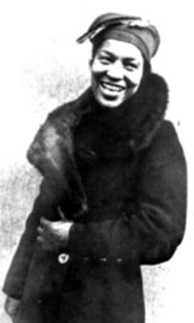Zora Neale Hurston
1989 Florida Folk Heritage Award

Zora Neale Hurston was an internationally acclaimed African American anthropologist, folklorist, and novelist. Hurston’s ethnographic study of her racial heritage, at a time when black culture was not a popular field of study, influenced the 1930s Harlem Renaissance writers as well as contemporary authors. Hurston was the next to the youngest of eight children. Her father was a Baptist preacher, tenant farmer, carpenter and later mayor of Eatonville, where he moved his family when Hurston was three. In her writings Hurston often depicted Eatonville, the first incorporated black community, as a place where black Americans could live independent of the prejudices of white society. However, her mother died when she was 9 and Hurston left home at 14 to join a traveling dramatic troupe.
Hurston later studied at Howard University, Columbia University and Barnard College. In 1928 she received an A.B. from Barnard, where she worked with anthropologist Franz Boas. From 1927-32, Hurston conducted field research in Florida, Alabama, Louisiana, and the Bahamas. Her first fieldwork was undertaken in Eatonville and the surrounding area, where she had maintained strong family connections. Her best-known folklore collection, Mules and Men (1935), included black music, games, oral lore and religious practices largely based on her field research in the area. She later collected folklore in Jamaica, Haiti, Bermuda, and Honduras. Tell My Horse (1938) was a collection of folklore from Jamaica and Haiti.
Hurston worked for the Works Progress Administration Federal Theatre Project in New York (1935-36) and the Federal Writers Program in Florida (1938). For the latter job, she again collected African American traditional culture in central Florida, and worked with folklorists Alan Lomax and Stetson Kennedy. She taught briefly at Bethune-Cookman College in Daytona Beach (1934) and at North Carolina College in Durham (1939). She also received Rosenwald and Guggenheim Fellowships (1934, 1936-37) and a Litt.D. from Morgan College in 1939.

